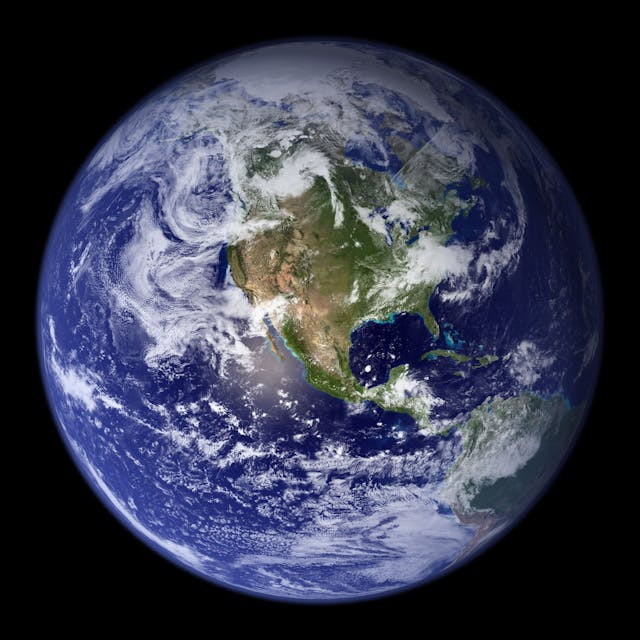
How many layers does the Earth have? At its simplest, the Earth has four layers. These are the crust, the mantle, the outer core, and the inner core. However, these layers can be divided up into smaller layers as well, depending on how you define a layer.
The crust is the rocky outer layer that we live on. The crust is between 10 and 65 km thick, depending on where you measure it. The crust under the oceans is thinner than the continental crusts. There are several reasons for this. The continental crust is made up of rocks that have a lower density than oceanic crust rocks. That means they take up more space. This lower density also makes the continental crusts float higher on the mantle than oceanic crusts, making them thicker. The continental crusts are also much older than the oceanic crusts, which are being replenished all the time. This extra age gives them more time to thicken. The crust is made up of plates that move around, crashing into each other, or climbing over each other. The crust is thin and brittle. It is only about 1% of the mass of the Earth.
The next layer down is the mantle. This is the largest part of the Earth and makes up 84% of the Earth’s volume. The mantle is about 2,900 km thick. Pictures in textbooks often show it as a yellow liquid, but the mantle is not actually a liquid. It is made of solid rock, although it does move like a viscous liquid. How is that possible? It stays solid because of the incredible pressures the rocks in the mantle are subjected to. The temperature deep in the mantle reaches 3,900 ℃, which is much higher than the melting temperature of rock. However, as we have learned in the past, the melting temperature and the boiling temperature of something increases or decreases depending on the pressure. Water boils at 100 ℃ at sea level, but it boils at 68 ℃ on the summit of Mt. Everest because of the low temperature. Conversely, if you could boil water at the bottom of the Mariana Trench, the pressure is so high that you would need to get the water to 524 ℃ before it would boil. This is because the high pressure crushes the molecules together and makes it much harder for them to break out of their solid form. They need far more energy to be able to do it. The pressure is so high in the mantle that even though the rocks are so hot, their melting point is even higher. The mantle is solid, but it can still move. It moves like a viscous liquid. Hot mantle from deep down rises and cooler mantle at the surface sinks down. This movement is not as fast as it sounds. It moves at a little over one centimeter a year. These are geological time scales.
The third layer is the outer core. It is 2,200 km thick. It is made of liquid iron and nickel. The metal is liquid because the pressure is extremely high, but so is the temperature. It reaches 4,500 ℃. Incidentally, if you were trying to boil water at the level of pressure in the outer core, you would have to get it to 2,855 ℃ to boil. The heat in the outer core is higher at the bottom than it is at the top and this causes convection currents. The currents make the outer core swirl around the inner core, and this produces an electric current and a magnetic field, just like a motor. If we didn’t have this core, we wouldn’t have a magnetic field, and the solar wind would probably have stripped our atmosphere off.
The inner core is made of solid iron. It is 1,221 km across. The temperature is about 5,200 ℃, but the pressure is much higher than in the outer core and the iron cannot melt. It is small, but it is extremely dense, and it makes up about 32.5% of the Earth’s mass. The core rotates in the same direction as Earth, but ever so slightly faster. It makes one extra rotation every 1,000 years. The core is getting bigger. It grows by about 1 mm every year. This is because the outer core is gradually losing heat and cooling down. The bottom part of the liquid outer core solidifies and sticks to the inner core. It grows by 8,820 tons every second, which sounds like a lot, but is a minute percentage of the core’s weight. And this is what I learned today.
Sources
https://www.amnh.org/exhibitions/permanent/planet-earth/how-has-the-earth-evolved/the-earths-crust
https://education.nationalgeographic.org/resource/resource-library-earth-structure
https://www.space.com/17777-what-is-earth-made-of.html
https://news.yale.edu/2022/06/30/thin-crust-or-thick-yale-researchers-try-solve-continental-question
https://en.wikipedia.org/wiki/Earth%27s_mantle
Photo by Pixabay: https://www.pexels.com/photo/planet-earth-87651/
